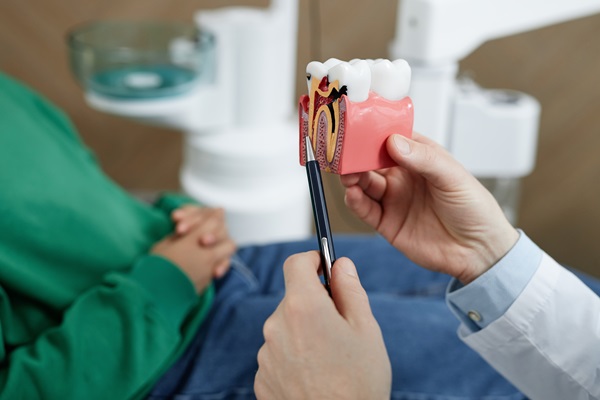Usually, when you see signs of decay or discoloration in your teeth and start feeling pain and discomfort, it goes far beyond what the eye can see.
The tooth’s layers go down right into the root canal, where the middle bottom part of the inside of your tooth is filled with pulp. This is considered a very delicate part of your tooth, and when there is damage in this area, it usually shows in the outer layers.
However, not every pain, discomfort or discoloration is solely because of an infected or compromised root canal.
To check if the symptoms you’re feeling may be caused by damage to your root canal, here’s a few warning signs you can look out for.
Signs That May Indicate the Need for Root Canal Therapy
Constant Tooth Pain
A good indicator is feeling a significant amount of pain caused by one of your teeth. What kind of pain do you watch out for?
Significant pain may need root canal treatment if it is ongoing tooth pain that lasts a long time, particularly when it’s intense or throbbing. This pain can range from a mild ache to sharp, sudden pains, and it might get worse when you chew or put pressure on the tooth.
Sensitivity to Temperature
Do you get tingling sensations in your tooth whenever you drink something hot or cold? What about the pain that shoots up in your tooth while doing the same?
If you feel more sensitive to hot or cold foods and drinks, it might mean there’s nerve damage or an infection in your tooth. This sensitivity can continue even after you’ve stopped eating or drinking hot or cold things.
Swelling and Tenderness
Swelling in the gums around the affected tooth, along with tenderness or discomfort, could mean there’s an infection that needs root canal treatment.
The swelling can vary from slight to noticeable and might cause visible changes in the gum tissue.
How Dentists Assess Your Root Canal
Clinical Examination
During a dental examination, your dentist will assess the health of your teeth and gums, looking for signs such as swelling, discolouration of the tooth, and sensitivity to touch. These indicators help determine if root canal therapy is necessary.
X-rays
X-rays are crucial for diagnosing issues within the tooth that may not be visible during a clinical examination alone. They can reveal signs of infection or damage to the tooth’s root canal system, aiding in the decision-making process for treatment.
Understanding The Root Canal Therapy Procedure
Root canal therapy typically involves several steps to effectively clean out the infected or damaged tissue from within the tooth:
Anaesthesia
Local anaesthesia is administered to ensure you remain comfortable throughout the procedure.
Accessing the Root Canal
Your dentist creates a small access hole in the tooth to reach the infected pulp and nerve tissue.
Cleaning and Shaping
Specialised tools are used to remove the infected tissue and clean the inside of the root canal thoroughly.
Filling the Canal
Once cleaned, the root canal is filled with a biocompatible material to seal it and prevent further infection.
Restoration
A filling or crown may be placed on the tooth to restore its function and protect it from further damage.
Aftercare and Recovery
After root canal therapy, it’s essential to follow your dentist’s instructions for aftercare, which may include:
Medication
Prescribed antibiotics or pain relievers, if necessary.
Rest and Recovery
Avoiding chewing on the treated tooth until it is fully restored.
Follow-Up Visits
Scheduled appointments to monitor healing and ensure the tooth is functioning properly.
Tooth Extraction as an Alternative
During extreme cases, this may be an alternative for some cases, depending on the advice of your dentist.
Most of the time, it’s usually better to save your natural tooth with root canal treatment instead of pulling it out. This keeps your dental structure strong and avoids needing more complicated treatments like dental implants or bridges.
Throughout all this, one important thing to note is that contrary to popular belief, root canal therapy is intended to relieve pain, not cause it. With the help of modern techniques and anaesthesia, patients are ensured to feel comfortable during the procedure.
Experience the Difference with Bellevue Hill Dental
Knowing the signs that show you might need root canal therapy and understanding the procedure can help ease worries and encourage getting treatment early. If you have ongoing tooth pain, sensitivity, or swelling, see your dentist right away to decide on the best way to improve your dental health.
At Bellevue Hill Dental, our comprehensive list of services helps you become ready to handle any oral emergency. We are able to assess your teeth and give a course of action that is tailored for you and your situation.
With a team that cares, you can easily find comfort and confidence, your smile. Book a consultation now or call our line at (02) 9158 1530.



